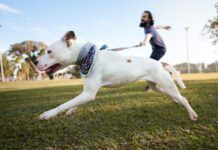I thought I knew what I was doing when I got my dog, Rupert, who is now 11. He was just four months old, but had already been identified as a failure at his intended career as a sheepdog on a working sheep ranch. He just wasn’t all that interested in sheep!
But for a long time now, we’ve lived in town where people are the most dominant figures on the landscape. And, just as he never took to sheep, Rupert has never really liked people. Or other dogs. Or noise. Ad infinitum.
What does Rupert like? It’s a short list, and even shorter if you lump all the things you can fetch into one item instead of cataloguing balls, Frisbees, sticks, and toys separately. He likes me, he likes my family, and though it took him a year or two to learn to recognize and trust them, he likes my next-door neighbors. Everyone else? Suspicious, unless they throw things for him and don’t try to pet him.
Hey, he’s a sensitive guy and just needs some space I used to think.
Until I took this job, and in my professional capacity, began to read books, watch videos, and attend demonstrations and lectures on dog training theories and methods, I thought I had done a good job raising and training Rupe. After all, his house manners are quiet and impeccable, he’s brilliant off-leash, and he’s so obedient he’d wait for several days on a down-stay if I asked him to. So he has a few funny peccadillos he would prefer to avoid people he doesn’t know, he never plays with other dogs, and he always crouches down on the floor of the car when we speed more than 30 miles per hour. So he has a few strange fears he runs out of the room if you fold laundry, he can’t stand sweeping (mopping is okay), and he trembles if people raise their voices.
Oh yeah; he’s also bitten a few people who tried to pet him when he was in some sort of position where he couldn’t get away from them. Is that his fault? No, it was mine.
My fault, because I didn’t know about socializing dogs. My fault, because I thought I was doing the right thing when I protected him from situations that made him nervous, instead of looking for what I now know are simple solutions to his peculiar problems which are not so peculiar for an unsocialized dog.
Through constant exposure to some of the most brilliant minds in the dog behavior and training world whether through their books, tapes, lectures, or, when I’m really lucky, one-on-one interviews and conversations I have learned what a failure I was in my early days and weeks with Rupert.
Had I known about proper socialization, he could have been twice the dog he is now. He’s as sweet and loving and obedient as can be, but he could have also been reliably friendly toward strange dogs and people, trustworthy with children, fearless in cars, and so much more. And he never would have bitten anyone, scared and a little trapped or not.
Fortunately, I’ve also learned that even adult dogs with behavior problems like Rupert’s (and I do now recognize them as behavior problems) can be partially rehabilitated. I’m applying what I’ve learned (and what we write about, all the time in WDJ) to desensitize Rupe to some of his fear triggers, to use classical conditioning to change the way he feels about other dogs and strange people and to improve his health with alternative therapies and an improved diet!
But, looking back over Rupert’s lifetime, I can see that the biggest mistake I ever made was not taking the opportunity to enroll him in a puppy training class. There, he could have made positive associations with noise and people and dogs. Instead, I protected him from the things that scared him – and he’s been scared ever since.
-NK





